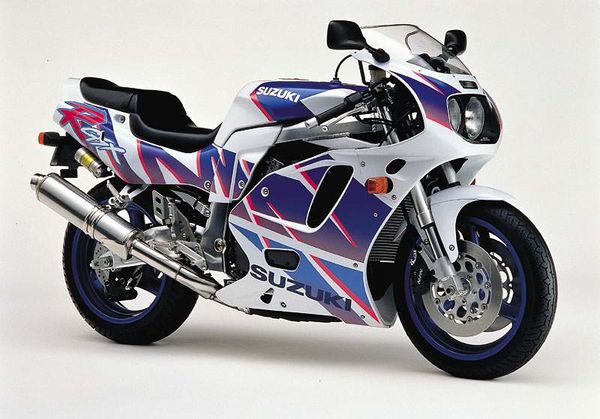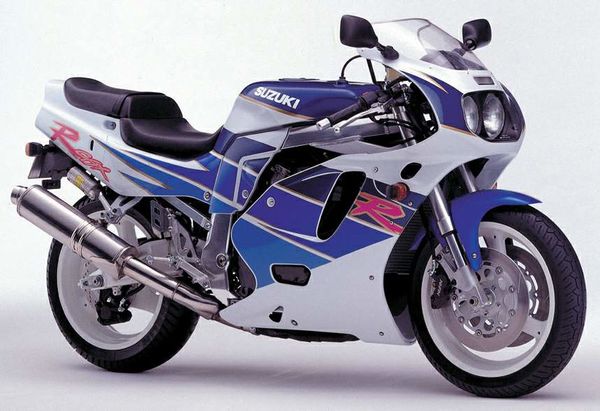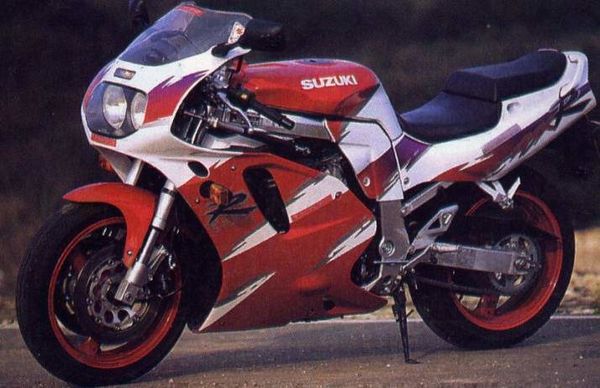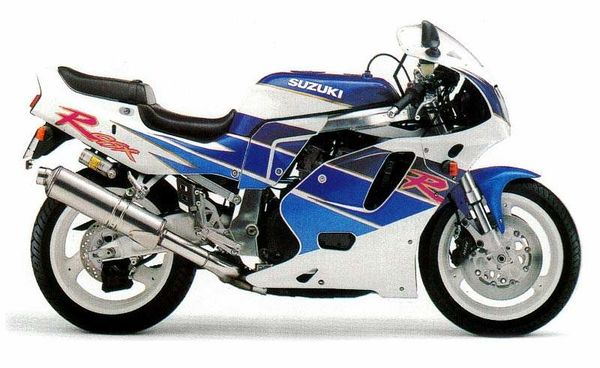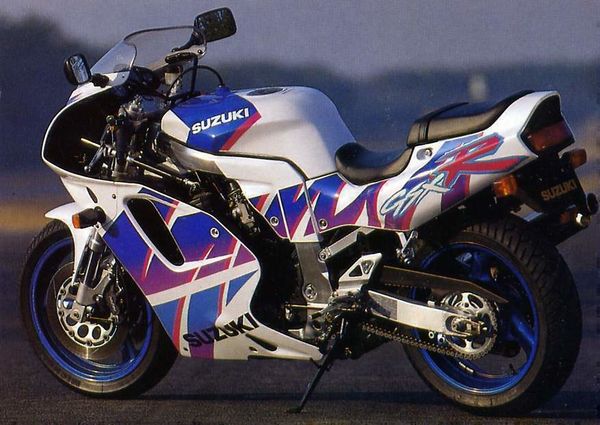Suzuki GSX-R 750WN
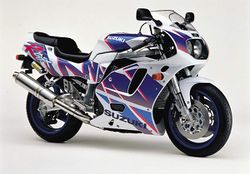 |
|
| Suzuki GSX-R 750WN | |
| Manufacturer | |
|---|---|
| Production | 1992 |
| Class | Sportbike |
| Engine | Four stroke, transverse four cylinder, DOHC, 4 valves per cylinder. |
| Compression ratio | 11.8:1 |
| Top Speed | 257.9 km/h / 160.3 mph |
| Ignition | Computer controlled electronic ignition |
| Spark Plug | NGK, CR9EK |
| Transmission | 6 Speed, constant mesh |
| Frame | 5-sided aluminum pipe frame with sand-casted steering head section and cast swing arm pivot |
| Suspension | Front: Showa 41 mm cartridge style upside-down forks, preload, compression and rebound adjustable Rear: Full floater, preload, compression and rebound adjustable |
| Brakes | Front: 2 x 310 mm Discs, 4 piston Nissin calipers Rear: Single 240 mm disc, 2 piston Nissin caliper |
| Front Tire | 120/70 ZR17 |
| Rear Tire | 170/60 ZR17 |
| Wheelbase | 1440 mm / 56.7 in. |
| Seat Height | 790 mm / 31.1 in |
| Weight | 208 kg / 458.6 lbs (dry), 234 kg / 516 lbs. (wet) |
| Recommended Oil | Suzuki ECSTAR 10w40 |
| Fuel Capacity | 21 Liters / 5.5 US US gal / 4.6 Imp gal |
| Manuals | Service Manual |
It could reach a top speed of 257.9 km/h / 160.3 mph.
Engine[edit | edit source]
The engine was a Liquid cooled cooled Four stroke, transverse four cylinder, DOHC, 4 valves per cylinder.. The engine featured a 11.8:1 compression ratio.
Drive[edit | edit source]
Power was moderated via the Cable operated, wet multiple, coil spring.
Chassis[edit | edit source]
It came with a 120/70 ZR17 front tire and a 170/60 ZR17 rear tire. Stopping was achieved via 2 x 310 mm Discs, 4 piston Nissin calipers in the front and a Single 240 mm disc, 2 piston Nissin caliper in the rear. The front suspension was a Showa 41 mm cartridge style upside-down forks, preload, compression and rebound adjustable while the rear was equipped with a Full floater, preload, compression and rebound adjustable. The GSX-R 750WN was fitted with a 21 Liters / 5.5 US US gal / 4.6 Imp gal fuel tank. The bike weighed just 208 kg / 458.6 lbs. The wheelbase was 1440 mm / 56.7 in. long.
Photos[edit | edit source]
Overview[edit | edit source]
Suzuki GSX-R 750WN
New liquid-cooled engine debuted for the 1992-year's GSX-R750WN (W meant
Water-cooling) to match and reduce the increasing heat under severe racing
conditions. However, the invaluable seven years of oil-cooling experience
was not abandoned completely and the new engine featured the best of both
worlds: oil injection piston cooling and water-cooled oil-cooler were among
the features incorporated into the new engine to achieve compactness and
reliability, enabling cylinder pitch reduction by 10mm and crankcase width
by 57mm
Headlight cover became cheaper/lighter plastic rather than the expensive
glass of the previous model. New 5-sided aluminum pipe frame with sand-casted
steering head section and cast swing arm pivot increased the torsional
resistance by 24%. The new monocoque swing arm was pressed arms of
asymmetrical design working with new link type rear suspension. In
isolation, a good bike but the other manufacturers had better bikes to
offer. Dry weight was still 208 kg and power was up to 118 hp at 11,500 rpm.
MAKE NO MISTAKE, this is an important bike. Important to you, important to anyone who gets off on racy 750s and, above all, important to Suzuki. The GSX-R has been Suzuki's image-maker since the very first was unveiled in 1985. Since then GSX-Rs have won Superstock championships, world endurance-championships and skipfuls of national and club championships. Since then the GSX-R has been through six different guises, each year slightly or sometimes substantially (as with the second generation Slingshot) modded from before, yet always retaining its characteristic twin beams, ally box-section double cradle frame and oil-cooled engine. And since then it's been Suzuki's biggest selling model.
Almost 100,000 worldwide sales-worth of biggest selling. It's that important. This, their seventh son, their third generation GSX-R, is different. It had to be. Last year's M model was, almost indisputably, the best handling, fastest, most exciting road 750 ever built. But that doesn't include RC30, OW01 and ZXR-R exotica, and because of it nor did the GSX-R still attract the sort of world championship-winning publicity and imagery that Suzuki long for its 'racer on the road'. So Suzuki has had a hefty rethink. Race competitiveness required more power, better cooling efficiency, less weight, better aerodynamics and, just as importantly, a more compact engine. (A race kit is to become available.) Continuing the GSX-R tradition, however, remaining faithful to more than 100,000 fans and, in short, not taking any gambles, also meant retaining the GSX-R's image, its look, its twin beams and ally cradle frame. So that's what the all-new GSX-R750WN has. The new water-cooled engine required to fulfil Part 1 of the brief retains some of the old GSX-R, its internal dimensions (bore and stroke stay 70 x 48.7mm), its 38mm slingshot Mikunis and, interestingly, an element of image-preserving oil-cooling. But that's where the similarities end. External dimensions have shrunk dramatically. The crankcases arc 57mm narrower thanks to moving the starter motor and generator behind the block. And the head is smaller, slimmer courtesy of a directly-actuated bucket and shim val-vetrain (bye-bye bulky rockers, hello doubled, 7500mile service intervals) and the use of a narrow, high compression combustion chamber with a 32 degree valve angle - down from 40. To shed weight, lightened valves and pistons are used; to improve strength and reliability in the face of an extra two bhp (and lob some of that weight back on) conrods, clutch and gearshafts are all beefier than before; and to keep it all under control, yes, it's.now water-cooled. A massive, curved ally rad sits in front of the frame's downtubes.
The same sort of 'change what-it-is but not what-it-looks-like' thinking has gone into the chassis. In other words, it's all new, but it don't look it. It's the same characteristic GSX-R ally double cradle but totally redesigned, strengthened, beefed-up...heavier. The frame rails and down tubes are larger, thicker. The rear sub-frame is now a racer-style, bend-and-replace, bolt-on jobbie. The sandcast headstock is more substantial and overall torsional rigidity is claimed to be improved by five per cent. The smaller, more compact engine is carried lower and further forward than before, lowering c of g and improving stability. Then again, overall weight is unchanged: whatever weight the engine lost was regained with the water-cooling and heavier, stronger chassis. Wouldn't it have been better going for a Dcl-tabox-style twin spar frame? No, it wouldn't have been a GSX-R, then would it? Suspension and brakes are the excellent if not the best kit as previously used on the M. Eminently twiddle-able upside-down forks and Full-Floater rising rate rear; 310mm discs and four-pot, dual opposed piston Nissin calipers. With one exception. To improve ground clearance the right-hand swing arm is now a skinny, pressed aluminum pent roof affair to enable the stainless four-into-two-into-one zorst to be tucked in even tighter. While clothing the whole caboodle is a new set of bodywork from the GSX-R wardrobe. Again, it looks identical to the M but isn't. Frontal area is slimmer, the number of panels and screws are fewer, the look (razzle-dazzle lightening col-urschemes apart) is somehow neater, simpler: clean, racy side covers over the frame rails, allegedly so's you can grip it wiv' your knees; a tasty, restyled rear light; a new, attractive console layout. From the seat everything has that aura of a seven year's worth of refinement rather than the hit-or-miss experimentation you sometimes get with a new model. The riding position is quite different. Compared to the M the bars are 15mm higher, 10mm further back and the seat's 10mm lower. It feels slightly smaller, the bars (for shorties) less of a stretch. Even the choke lever (at last) is now handily mounted on the 'bar.
And it goes like bleedin' stink.
Thirty laps or so of Suzuki's Ryuyo test track won't tell you much about
living with the bike on Blighty's hotch-potch of roads. That'll come with a full
test. But it does reveal oodles about the new GSX-R's strength, its raison
d'etre its abilities as a pure sports bike on the edge.
Held wide open down the long two-mile straight produced an indicated 150mph,
1500rpm shy of the 13,500rpm redline (expect a genuine 150mph-plus with a slight
tailwind.) From 8000 up to there it'd been progressive, distinctively less peaky
than the M, less raucous, more refined, smoother and pulling almost as
effortlessly, with a deep tenor growl from around six. But below that, forget it
buy a VFR. The gearbox and clutch are typical Suzuki brilliant. In fact all
the controls are brilliant. Small, dainty, max-control bar grips; a
span-adjustable, brick wall-power, single finger-control front brake lever, and
one of the most sensitive, most predictable clutches I've ever used. Ally that
with a crisp, responsive (and very light) throttle action and the task of
keeping the dancing tacho needle exactly where you want it is sheer revelry
rather than a chore.
But best of all is its balance. The .riding position may be less extreme but,
because of other design mods, more weight is over the front. The suspension may
be unchanged (it was among the best already) and the steering geometry only
mildy tighter with less trail, but the wheelbase is longer, the frame stiffer,
the stability greater, and all combine to heighten further the response from the
diamond front end. Brake, flick, carve, hold, nail...enjoy.
How much better it is than the M, after all those subtle mods, after all that
work, is debateable. The front end is definitely improved but it couldn't
get much better. The engine is faster, smoother, more progressive but it was
the fastest in its class before. And you can argue 'til your teeth fall out
about whether Suzuki might not have been better off spending all that R&D on a
twin spar frame etc instead of persisiting with the GSX-R's double cradle. But
as it stands, they really didn't need to. The best has just got better. Lumme,
and I thought the old one was pretty good.
| Make Model | Suzuki GSX-R 750WN |
|---|---|
| Year | 1992 |
| Engine Type | Four stroke, transverse four cylinder, DOHC, 4 valves per cylinder. |
| Displacement | 749 c / 45.7 cub. in. |
| Bore X Stroke | 70 x 48.7 mm |
| Compression | 11.8:1 |
| Cooling System | Liquid cooled |
| Engen Oil | Synthetic,10W/40 |
| Exhaust System | 4-into-2-into-1 Stainless-steel exhaust |
| Lubrication | Wet sump |
| Induction | 4 x 38 mm Mikuni BST38SS carburetors |
| Ignition | Computer controlled electronic ignition |
| Spark Plug | NGK, CR9EK |
| Starting | Electric |
| Max Power | 88 kW / 118 hp @ 11500 rpm |
| Max Power Rear Tire | 80.4 kW / 107.8 hp @ 11200 rpm |
| Max Torque | 80 Nm / 8.2 kgf-m / 59 ft-lb @ 10000 rpm |
| Clutch | Cable operated, wet multiple, coil spring |
| Transmission | 6 Speed, constant mesh |
| Final Drive | #530 Chain, O-ring sealed, 108 links |
| Gear Ratios | 1st 2.77 / 2nd 2.25 / 3rd 1.65 / 4th 1.40 / 5th 1.23 / 6th 1.09:1 |
| Frame | 5-sided aluminum pipe frame with sand-casted steering head section and cast swing arm pivot |
| Front Suspension | Showa 41 mm cartridge style upside-down forks, preload, compression and rebound adjustable |
| Front Wheel Travel | 120 mm / 4.7 in. |
| Rear Suspension | Full floater, preload, compression and rebound adjustable |
| Front Brakes | 2 x 310 mm Discs, 4 piston Nissin calipers |
| Rear Brakes | Single 240 mm disc, 2 piston Nissin caliper |
| Wheels | Alloy, 3 spoke |
| Front Rim | 3.5 x 17 |
| Front Tire | 120/70 ZR17 |
| Rear Rim | 5.5 x 17 |
| Rear Tire | 170/60 ZR17 |
| Rake | 24.5° |
| Trail | 94 mm / 3.7 in. |
| Wheelbase | 1440 mm / 56.7 in. |
| Dimensions | Length 2070 mm / 81.5 in. Width 730 mm / 28.7 in. Height 1135 mm / 44.7 in. |
| Seat Height | 790 mm / 31.1 in |
| Dry Weight | 208 kg / 458.6 lbs |
| Wet Weight | 234 kg / 516 lbs. |
| Fuel Capacity | 21 Liters / 5.5 US US gal / 4.6 Imp gal |
| Average Consumption | 7.1 L100 km / 14 km/l / 32.9 US mpg / 39.8 Imp mpg |
| Braking 100kmh - 0 / 60 Mph - 0 | 36.7 m / 120.4 ft |
| Braking 60 Kmh - 0 / 37 Mph - 0 | 12.9 m / 42.3 ft |
| Standing ¼ Mile | 10.7 sec / 206 km/h / 128 mph |
| Top Speed | 257.9 km/h / 160.3 mph |
| Colours | White/Blue, Red/White |
| Source | Cycle World |
